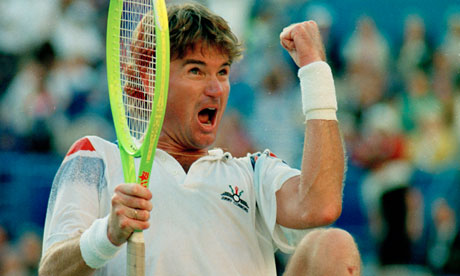
Like most great tennis players of the million-dollar era, the career of Jimmy Connors began prenatally. As with Andy Murray, his Grand Slam gene was passed down the maternal line. Connors's grandmother, known as Two-Mom, had been a champion in their native East St Louis in the 1930s; his mother, Gloria, had a few years on the national women's circuit in America after the war, and had subsequently coached film stars in LA. But the real work of those two generations, as this suitably in-your-face memoir reveals, began only when young Jimbo picked up a racket. From as soon as he could walk, Gloria and Two-Mom would fire tennis balls at him on the public courts with full force, in order, as his mother said, to "get his tiger juices flowing". The toddler Connors, grasping his racket with his trademark double fisted grip, would quickly learn how to fire them back just as hard.
He had other things going for him as a tennis prodigy: an "ocular motor sensory deficit" meant that he had problems reading, so he needed an arena to compete outside of the classroom. As well as a mother he admits to calling "ten times a day" throughout his life, he had an often absent father, whose approval he craved. And he was, or became, profoundly obsessive compulsive – always bouncing a tennis ball a certain number of times before serving; always pursuing the same pre-match routine; a hand-washer and door-checker (living out of a hotel room was a relief in that respect – only one lock to remember). He unusually married this need for control with a gambler's spirit, a fascination with risk, that became, as he reveals here, an expensive and destructive addiction once he stopped playing (the night after a victory on the seniors tour, he had a habit of blowing his winnings on a single roll of a dice).
For a decade or more, though, from the mid-70s to the mid-80s, Connors held all these forces in uneasy balance and used them to fuel an almost incomparable will to prevail on the tennis court. Some rivals from that stellar period – McEnroe, Nastase – had a far greater range of shot than him. Others – Borg, Lendl – were more than a match for his athleticism. But no one ever made winning look quite the rutting alpha-male necessity that Connors made it appear. (It is hard to imagine Roger Federer, for example, simulating sex with a frenzied crowd between points at the US Open at Flushing Meadows, as Jimbo had a habit of doing).
His book is mostly written in this testosterone-induced spirit. More than once, for example, he tells his gentle reader to "fuck off". The Outsider has little of the tortured introspection of the best example of the genre, Andre Agassi's Open, or the self-aware wit of McEnroe's Serious. In its place is an examination of a legendary American pugnaciousness, which veers often, authentically, into boorishness or sentimentality. Connors ungallantly – or in the interests of telling it like it was – reveals in passing the terminated pregnancy that led to his splitting from 19-year-old Chris Evert. He recalls his marriage proposal to his slightly long-suffering wife Patti, one of Hugh Hefner's former Playmates of the Year, in the following terms, "Let's go back to the hotel and make a baby."
In his eight-time Grand Slam-winning glory days he doesn't appear to have liked himself any more than most other people seemed to. Of course, he'd have us believe that age (he's 60 now, a veteran of three hip replacements) and mortality (his mother's death hit him particularly hard) have made him wiser. But, again of course, he'd do none of it differently. Not the obsession, nor the self-destruction, the pain nor the partying. Not even what he calls the "spontaneous assholery". Particularly not that.

